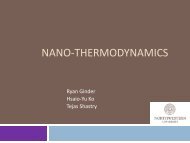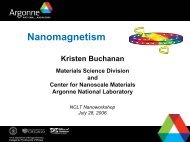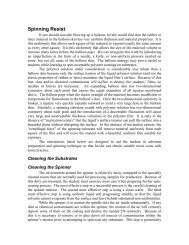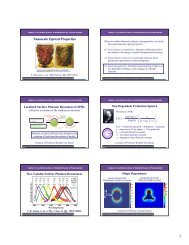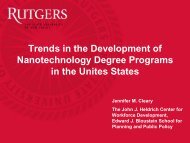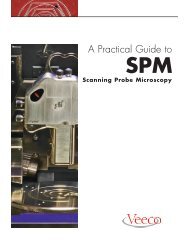Manipulation of Light in the Nano World - NCLT
Manipulation of Light in the Nano World - NCLT
Manipulation of Light in the Nano World - NCLT
Create successful ePaper yourself
Turn your PDF publications into a flip-book with our unique Google optimized e-Paper software.
National Center <strong>of</strong> Learn<strong>in</strong>g and Teach<strong>in</strong>g<br />
- <strong>Manipulation</strong> <strong>of</strong> <strong>Light</strong> <strong>in</strong> <strong>the</strong> <strong>Nano</strong> <strong>World</strong><br />
Boyang Liu<br />
Department <strong>of</strong> Electrical Eng<strong>in</strong>eer<strong>in</strong>g and Computer Science
http://policy.iop.org/Policy/<br />
<strong>Nano</strong>technology has become globally<br />
popular. However, it is surrounded by<br />
a state <strong>of</strong> confusion, because it is<br />
different from o<strong>the</strong>r tangible<br />
technologies, and it lacks educational<br />
effort to promote <strong>the</strong> correct image to<br />
society.<br />
One effective way to close gap<br />
between cutt<strong>in</strong>g-edge nanotechnology<br />
research and education is to use<br />
<strong>in</strong>teractive computer simulat<strong>in</strong>g and<br />
model<strong>in</strong>g learn<strong>in</strong>g programs.<br />
Department <strong>of</strong> Electrical Eng<strong>in</strong>eer<strong>in</strong>g and Computer Science
Simulations <strong>of</strong> Double Slits<br />
• Interactive User Interface<br />
Department <strong>of</strong> Electrical Eng<strong>in</strong>eer<strong>in</strong>g and Computer Science
• With <strong>in</strong>teractive user <strong>in</strong>terface, users could choose slit size, slit space and<br />
wavelength <strong>of</strong> <strong>in</strong>cidental light. The simulation is based on real calculation<br />
<strong>of</strong> Electromagnetic field <strong>of</strong> <strong>the</strong> whole region with precise approximations.<br />
Slit size= λ<br />
Slit size=10 λ<br />
Department <strong>of</strong> Electrical Eng<strong>in</strong>eer<strong>in</strong>g and Computer Science
Simulations <strong>of</strong> Photonic Band Gap<br />
http://www.amolf.nl/publications/<strong>the</strong>ses/velikov/<br />
• Simulation <strong>of</strong> PBG is part <strong>of</strong> a<br />
design project <strong>in</strong> <strong>NCLT</strong> <strong>Light</strong><br />
Group. It’s based on real PBG<br />
materials (Polystyrene), which<br />
could be produced by students<br />
<strong>the</strong>mselves. The goal is to make<br />
students be able to produce PBG<br />
materials by <strong>the</strong>mselves, toge<strong>the</strong>r<br />
with <strong>the</strong> real simulation.<br />
Department <strong>of</strong> Electrical Eng<strong>in</strong>eer<strong>in</strong>g and Computer Science
• Introduction:<br />
Photonic band gap (PBG) materials are crystall<strong>in</strong>e structures that<br />
exclude light transmission for specific wavelength ranges, just as<br />
semiconductors exclude electron propagation for certa<strong>in</strong> energy<br />
bands.<br />
• Photonic Bandgap Structure, pre-designed based on real PBG sample:<br />
a) Crystal Structure: Face-Centered Cubic (FCC)<br />
b) Refractive Index <strong>of</strong> PBG material: 1.59<br />
c) Particle Size (Diameter): 258nm<br />
Department <strong>of</strong> Electrical Eng<strong>in</strong>eer<strong>in</strong>g and Computer Science
• Properties <strong>of</strong> Photonic Band Gap Material:<br />
1) λ Input light ≠ λ PBG : Most energy <strong>of</strong> light pass through<br />
λ Input light = λ PBG : Little energy <strong>of</strong> light pass through<br />
2) When <strong>in</strong>cidental angle (α) changes, <strong>the</strong> central wavelength (λ<br />
PBG) <strong>of</strong> PBG material shifts accord<strong>in</strong>gly.<br />
α<br />
TM<br />
PBG Material<br />
TE<br />
Photonic Band Gap Material<br />
Department <strong>of</strong> Electrical Eng<strong>in</strong>eer<strong>in</strong>g and Computer Science
Normal Incident<br />
λ Input light ≠λ PBG (560nm) : most light passes through<br />
Department <strong>of</strong> Electrical Eng<strong>in</strong>eer<strong>in</strong>g and Computer Science
Normal Incident<br />
λ Input light = λ PBG (560nm) : little light pass through<br />
Department <strong>of</strong> Electrical Eng<strong>in</strong>eer<strong>in</strong>g and Computer Science
• Central wavelength Changes with Incidental angle<br />
Incidental<br />
Angle (α)<br />
0 20 24.5 29 34 38 49 55 59.5<br />
λ PBG (nm) 560 556 550 548 523 519 509 494 460<br />
Incident Angle α=38 °, λ PBG shifts from 560nm to 519nm<br />
λ Input light = λ PBG (519nm) : little light pass through<br />
Department <strong>of</strong> Electrical Eng<strong>in</strong>eer<strong>in</strong>g and Computer Science



